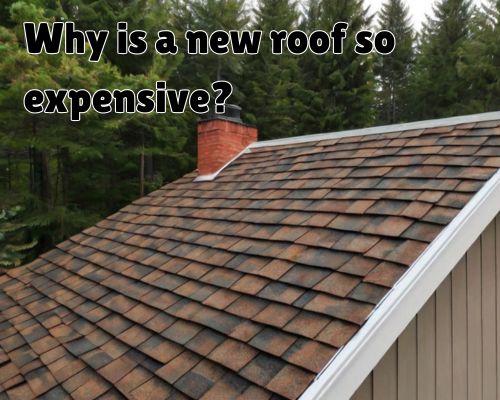A new roof is one of the most significant investments homeowners in West Palm Beach, Florida, will face. Many property owners are surprised by the high cost of roof replacement and wonder, “Why is a new roof so expensive?” This guide breaks down the key factors contributing to roofing costs, including materials, labor, permitting, and the local economic environment. Understanding these elements will help homeowners make informed decisions when planning their roofing projects.

Factors That Influence the Cost of a New Roof in West Palm Beach
1. High-Quality Roofing Materials
One of the primary reasons a new roof is expensive is the cost of materials. In West Palm Beach, where extreme weather conditions such as hurricanes and heavy rainfall are common, homeowners must invest in durable roofing materials that meet Florida’s strict building codes. Popular roofing options include:
- Asphalt Shingles – The most affordable option, but still pricier in South Florida due to the need for enhanced wind resistance.
- Metal Roofing – A long-lasting and hurricane-resistant option but more expensive due to material and installation costs.
- Tile Roofing – Common in Florida, particularly in Mediterranean-style homes, but significantly more expensive due to weight, durability, and installation labor.
- Flat Roofing (TPO & Modified Bitumen) – Often used for commercial buildings but also popular in residential homes, requiring specialized labor.
Since these materials must comply with Florida’s stringent regulations, manufacturers produce reinforced versions, increasing overall costs.
2. Labor Costs and Skilled Workforce
West Palm Beach has a high demand for skilled roofers, driving up labor costs. Roof installation is labor-intensive, requiring expertise in:
- Removing old roofing material
- Inspecting and repairing structural damage
- Properly installing new roofing to withstand hurricanes
- Complying with Florida Building Code (FBC) regulations
Additionally, a shortage of experienced roofers in Florida means roofing companies must offer competitive wages, increasing overall installation expenses.
3. Stringent Building Codes and Permitting Requirements
Florida has some of the strictest roofing codes in the country due to the high risk of hurricanes. Roofing projects must meet specific wind mitigation standards, requiring specialized materials and installation techniques. These regulations ensure safety but also increase costs due to:
- Additional inspections
- Permit fees required by the City of West Palm Beach
- Reinforced underlayment to prevent wind and water damage
Local permits can cost several hundred dollars, adding to the total expense of a roof replacement.
4. Insurance and Liability Expenses
Roofing contractors like Star Roofing in West Palm Beach carry substantial insurance coverage, including:
- General Liability Insurance – Protects homeowners in case of accidental property damage.
- Workers’ Compensation – Covers injuries sustained by roofers on the job.
These mandatory insurances contribute to overhead costs, which are factored into roofing estimates.
5. Hurricane and Storm Protection Requirements
West Palm Beach is in a hurricane-prone region, meaning roofs must be built to withstand extreme winds and heavy rainfall. Enhanced protection measures add to the overall expense, such as:
- Hurricane straps and tie-downs
- Wind-resistant shingles
- Secondary water barriers
Meeting these requirements increases both material and labor costs, but it provides homeowners with added safety and peace of mind.
6. Roof Complexity and Size
The size and design of a roof significantly impact the total cost. Factors that influence complexity include:
- Steep slopes requiring additional safety measures
- Multiple roof levels
- Additional features like skylights, chimneys, and dormers
A larger or more complex roof requires more materials, labor, and time, leading to higher costs.
7. Rising Material and Transportation Costs
Supply chain disruptions and inflation have driven up the cost of roofing materials. Additionally, transporting heavy materials like tiles or metal roofing panels to West Palm Beach adds logistical expenses.
8. Energy-Efficient and Impact-Resistant Roofing
Many homeowners in West Palm Beach opt for energy-efficient roofing materials to reduce cooling costs. Solar-reflective shingles, metal roofs, and specialized coatings can increase the upfront cost but provide long-term savings on energy bills. Impact-resistant roofing materials also cost more but offer better protection against storms and hail damage.
Ways to Reduce the Cost of a New Roof in West Palm Beach
While a new roof is a major investment, there are ways to manage costs effectively:
1. Get Multiple Quotes
Always request estimates from at least three licensed roofing contractors to compare prices and services. See Star Roofing for good costing.
2. Check for Roofing Incentives and Tax Credits
Florida homeowners may qualify for:
- Wind mitigation insurance discounts
- Energy-efficient roofing tax credits
- Local rebate programs for eco-friendly roofing materials
3. Schedule Roofing Work During the Off-Season
Summer and hurricane season increase roofing demand, driving up prices. Scheduling roof work in the cooler months may result in better pricing and availability.
4. Consider Roofing Financing Options
Many roofing companies in West Palm Beach offer financing plans to help spread the cost of a new roof over several years.
5. Maintain Your Current Roof
Regular roof inspections and minor repairs can extend the lifespan of your roof, delaying the need for a costly replacement.
Conclusion
The high cost of a new roof in West Palm Beach, Florida, is due to multiple factors, including premium materials, labor expenses, strict building codes, and storm-proofing requirements. While these costs may seem overwhelming, investing in a high-quality roof provides long-term benefits, including increased property value, better protection against extreme weather, and lower insurance premiums.
Understanding these factors can help homeowners make informed decisions when planning their roof replacement. By exploring financing options, seeking rebates, and choosing the right materials, homeowners can balance cost with durability and protection.